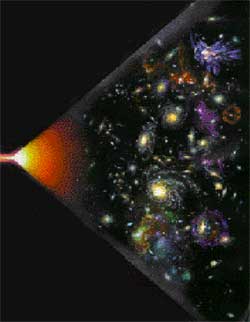The Universe Goes Nuclear

In honor of the World Year of Physics, which commemorates Einstein’s “miraculous year” in 1905, we’re presenting papers from the Physical Review archive related to Einstein’s accomplishments.
By the late 1940s, most scientists agreed that the universe is expanding and that it must have been much denser in the past. But no one had thought much about the physical state of the universe in its earliest moments, or how it would lead to the universe we see today. In 1948, three physicists used a mathematical model of an expanding universe, derived from Einstein’s general relativity, to investigate how nuclear reactions would generate chemical elements when the universe was very young. Their results seemed to match astronomers’ measurements of element abundances, and although their ideas were wrong in some important ways, the paper set the foundation for what is now the widely-accepted big bang theory.
In a 1946 paper, George Gamow, of George Washington University in Washington, DC, was the first to look at the effects of cosmic expansion on the nuclear matter that must have existed in the early universe. General relativity predicts such a rapid early expansion that all of the element-generating nuclear reactions must have occurred within seconds, he found [1].
Gamow was a notoriously sloppy calculator, so in order to calculate the amounts of various elements produced in his scenario, he enlisted the help of Ralph Alpher, a graduate student at the Applied Physics Laboratory of Johns Hopkins University, then in Silver Spring, Maryland. Puckishly, he added nuclear expert Hans Bethe of Cornell University in Ithaca, New York, to the author list of the 1948 paper, because the three names sounded like the first three letters of the Greek alphabet. Alpher, Bethe, and Gamow proposed that the universe began in the form of a neutron fluid, the densest kind of matter they could imagine. As this material expanded, free neutrons would have begun to decay into protons and electrons, and some of those protons would have captured remaining neutrons to form deuterium. Further neutron capture would have built up heavier elements, yielding cosmic element abundances in rough agreement with values deduced by astronomers from the spectra of starlight.
Analyses over the following two decades changed the picture considerably, however. According to later theories, the initial state was not a neutron fluid but a mix of neutrons and protons in a ratio controlled by the temperature, and the neutron-capture mechanism proved unable to make elements beyond helium. By the 1960s it was clear that cosmic nuclear reactions generated helium, traces of deuterium and lithium, and essentially nothing else. All other elements formed later, inside stars and supernovae. Nonetheless, says David Weinberg of Ohio State University in Columbus, “there is historical influence all the way through” from Alpher, Bethe, and Gamow to current cosmological models.
In further work in 1948 and ‘49 [2] Gamow and others showed that the early universe would have been so hot that the energy of radiation would have had a larger gravitational effect than matter. They also showed that the universe today should contain a much-cooled remnant of this radiation, although that prediction was forgotten until the 1960s, when the discovery of the cosmic microwave background became the first real evidence that the universe had once been hot and dense.
Given the shortcomings of their theoretical arguments, it was largely luck, says Weinberg, that Gamow and his collaborators came up with predictions that were not too far off the mark. But the broad picture–a hot early universe with nuclear reactions limited by the rate of expansion–was correct, he adds, and for that vision they deserve credit.
–David Lindley
David Lindley is a freelance science writer, now retired. His most recent book is The Dream Universe: How Fundamental Physics Lost Its Way (Penguin Random House, 2020).
References
- G. Gamow, “Expanding Universe and the Origin of Elements,” Phys. Rev. 70, 572 (1946)
- G. Gamow, “The Origin of Elements and the Separation of Galaxies,” Phys. Rev. 74, 505 (1948); G. Gamow, “Evolution of the Universe,” Nature 162, 680 (1948); R. A. Alpher and R. C. Herman, “Evolution of the Universe,” Nature 162, 774 (1948); R. A. Alpher and R. C. Herman, “Remarks on the Evolution of the Expanding Universe,” Phys. Rev. 75, 1089 (1949)


